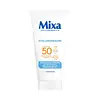What's inside
What's inside
 Key Ingredients
Key Ingredients

 Benefits
Benefits

 Concerns
Concerns

 Ingredients Side-by-side
Ingredients Side-by-side

Water
Skin ConditioningDicaprylyl Carbonate
EmollientMethylene Bis-Benzotriazolyl Tetramethylbutylphenol
UV FilterButyl Methoxydibenzoylmethane
UV AbsorberEthylhexyl Triazone
UV AbsorberNylon-12
C20-22 Alkyl Phosphate
EmulsifyingGlycerin
HumectantC20-22 Alcohols
Emulsion StabilisingDecyl Glucoside
CleansingButylene Glycol
HumectantDimethicone
EmollientXanthan Gum
EmulsifyingChlorphenesin
AntimicrobialParfum
MaskingTriacontanyl Pvp
HumectantBenzoic Acid
MaskingTetrasodium EDTA
O-Cymen-5-Ol
AntimicrobialTocopheryl Acetate
AntioxidantSodium Hydroxide
BufferingPropylene Glycol
HumectantCitric Acid
BufferingGlycyrrhiza Inflata Root Extract
Skin ConditioningWater, Dicaprylyl Carbonate, Methylene Bis-Benzotriazolyl Tetramethylbutylphenol, Butyl Methoxydibenzoylmethane, Ethylhexyl Triazone, Nylon-12, C20-22 Alkyl Phosphate, Glycerin, C20-22 Alcohols, Decyl Glucoside, Butylene Glycol, Dimethicone, Xanthan Gum, Chlorphenesin, Parfum, Triacontanyl Pvp, Benzoic Acid, Tetrasodium EDTA, O-Cymen-5-Ol, Tocopheryl Acetate, Sodium Hydroxide, Propylene Glycol, Citric Acid, Glycyrrhiza Inflata Root Extract
Water
Skin ConditioningIsopropyl Myristate
EmollientGlycerin
HumectantEthylhexyl Triazone
UV AbsorberC12-15 Alkyl Benzoate
AntimicrobialZea Mays Starch
AbsorbentNiacinamide
SmoothingDiisopropyl Sebacate
EmollientBis-Ethylhexyloxyphenol Methoxyphenyl Triazine
Skin ConditioningDimethicone
EmollientButyl Methoxydibenzoylmethane
UV AbsorberPotassium Cetyl Phosphate
EmulsifyingStearyl Alcohol
EmollientGlyceryl Stearate
EmollientPEG-100 Stearate
Perlite
AbsorbentDrometrizole Trisiloxane
UV AbsorberTerephthalylidene Dicamphor Sulfonic Acid
UV AbsorberTriethanolamine
BufferingSilica
AbrasivePhenylethyl Resorcinol
AntioxidantAmmonium Polyacryloyldimethyl Taurate
Emulsion StabilisingPoloxamer 338
EmulsifyingTocopherol
AntioxidantHydroxyacetophenone
AntioxidantCaprylyl Glycol
EmollientCapryloyl Salicylic Acid
ExfoliatingHydrolyzed Hyaluronic Acid
HumectantTrisodium Ethylenediamine Disuccinate
Xanthan Gum
EmulsifyingWater, Isopropyl Myristate, Glycerin, Ethylhexyl Triazone, C12-15 Alkyl Benzoate, Zea Mays Starch, Niacinamide, Diisopropyl Sebacate, Bis-Ethylhexyloxyphenol Methoxyphenyl Triazine, Dimethicone, Butyl Methoxydibenzoylmethane, Potassium Cetyl Phosphate, Stearyl Alcohol, Glyceryl Stearate, PEG-100 Stearate, Perlite, Drometrizole Trisiloxane, Terephthalylidene Dicamphor Sulfonic Acid, Triethanolamine, Silica, Phenylethyl Resorcinol, Ammonium Polyacryloyldimethyl Taurate, Poloxamer 338, Tocopherol, Hydroxyacetophenone, Caprylyl Glycol, Capryloyl Salicylic Acid, Hydrolyzed Hyaluronic Acid, Trisodium Ethylenediamine Disuccinate, Xanthan Gum
 Reviews
Reviews

Ingredients Explained
These ingredients are found in both products.
Ingredients higher up in an ingredient list are typically present in a larger amount.
Also known as Avobenzone, this ingredient is a chemical sunscreen filter that provides protection in the UV-A range.
Avobenzone is globally approved and is the most commonly used UV-A filter in the world.
Studies have found that avobenzone becomes ineffective when exposed to UV light (it is not photostable; meaning that it breaks down in sunlight). Because of this, formulations that include avobenzone will usually contain stabilizers such as octocrylene.
However, some modern formulations (looking at you, EU!) are able to stabilize avobenzone by coating the molecules.
Avobenzone does not protect against the UV-B range, so it's important to check that the sunscreen you're using contains other UV filters that do!
The highest concentration of avobenzone permitted is 3% in the US, and 5% in the EU.
Learn more about Butyl MethoxydibenzoylmethaneDimethicone is a type of synthetic silicone created from natural materials such as quartz.
What it does:
Dimethicone comes in different viscosities:
Depending on the viscosity, dimethicone has different properties.
Ingredients lists don't always show which type is used, so we recommend reaching out to the brand if you have questions about the viscosity.
This ingredient is unlikely to cause irritation because it does not get absorbed into skin. However, people with silicone allergies should be careful about using this ingredient.
Note: Dimethicone may contribute to pilling. This is because it is not oil or water soluble, so pilling may occur when layered with products. When mixed with heavy oils in a formula, the outcome is also quite greasy.
Learn more about DimethiconeEthylhexyl Triazone is a modern chemical sunscreen that protects from UV-B radiation.
It is the most effective of existing UV-B filters, as it provides the highest level of photo-stable absorption. It protects from the entire UV-B range (280 to 320nm), with it's highest level of protection at 314nm.
Ethylhexyl Triazone is oil soluble, oderless and colorless, which mean it is able to be incorporated into a variety of different formulations.
It is not currently available within the United States due to slow changing FDA regulations. Outside of the US, it is used in formulations at concentrations up to 5%.
Learn more about Ethylhexyl TriazoneGlycerin is already naturally found in your skin. It helps moisturize and protect your skin.
A study from 2016 found glycerin to be more effective as a humectant than AHAs and hyaluronic acid.
As a humectant, it helps the skin stay hydrated by pulling moisture to your skin. The low molecular weight of glycerin allows it to pull moisture into the deeper layers of your skin.
Hydrated skin improves your skin barrier; Your skin barrier helps protect against irritants and bacteria.
Glycerin has also been found to have antimicrobial and antiviral properties. Due to these properties, glycerin is often used in wound and burn treatments.
In cosmetics, glycerin is usually derived from plants such as soybean or palm. However, it can also be sourced from animals, such as tallow or animal fat.
This ingredient is organic, colorless, odorless, and non-toxic.
Glycerin is the name for this ingredient in American English. British English uses Glycerol/Glycerine.
Learn more about GlycerinWater. It's the most common cosmetic ingredient of all. You'll usually see it at the top of ingredient lists, meaning that it makes up the largest part of the product.
So why is it so popular? Water most often acts as a solvent - this means that it helps dissolve other ingredients into the formulation.
You'll also recognize water as that liquid we all need to stay alive. If you see this, drink a glass of water. Stay hydrated!
Learn more about WaterXanthan gum is used as a stabilizer and thickener within cosmetic products. It helps give products a sticky, thick feeling - preventing them from being too runny.
On the technical side of things, xanthan gum is a polysaccharide - a combination consisting of multiple sugar molecules bonded together.
Xanthan gum is a pretty common and great ingredient. It is a natural, non-toxic, non-irritating ingredient that is also commonly used in food products.
Learn more about Xanthan Gum